Browser Client - Web-based Remote Access
NetBird's Browser Client enables secure remote access to SSH and RDP resources directly from your web browser, without requiring any client software installation. This feature runs a NetBird peer as WebAssembly (WASM) in your browser, establishing secure connections through your existing NetBird network.
Overview
The Browser Client provides instant, secure remote access through your browser:
- No installation required - Works directly in your browser without any software downloads
- SSH and RDP support - Access Linux and Windows machines with complete protocol implementations
- Secure by design - All connections are encrypted end-to-end with WireGuard®
- True peer-to-peer - Runs a complete NetBird peer as WebAssembly in your browser
- Works anywhere - Access your resources from any device with a modern web browser
The Browser Client is a real NetBird peer running entirely in your browser. The management server does not connect to target machines - all connections are made directly from your browser to the target peer through the NetBird network.
Prerequisites
Before using the Browser Client, ensure:
- Admin privileges - You must be logged into the NetBird dashboard with an admin account (required for temporary ACL creation)
- Protocol requirements:
- For SSH: The NetBird SSH server must be enabled on the target peer. Learn more about enabling SSH access.
- For RDP: The RDP server must be enabled on the target machine
- Modern browser - You're using an up-to-date version of Chrome, Firefox, Edge, or Safari with WebAssembly support
Accessing Machines via the Browser Client
Quick Access from the Peers List
The easiest way to connect is directly from the Peers dashboard:
- Navigate to the Peers section in your NetBird dashboard
- Find the peer you want to access
- In the Remote Access section, click the SSH or RDP button

SSH Connection
When connecting via SSH:
- Click the SSH button for your target peer
- A credentials modal will appear
Before connecting via SSH, make sure that SSH Access is enabled both on the target peer and in the NetBird Dashboard. Learn more about enabling SSH access.
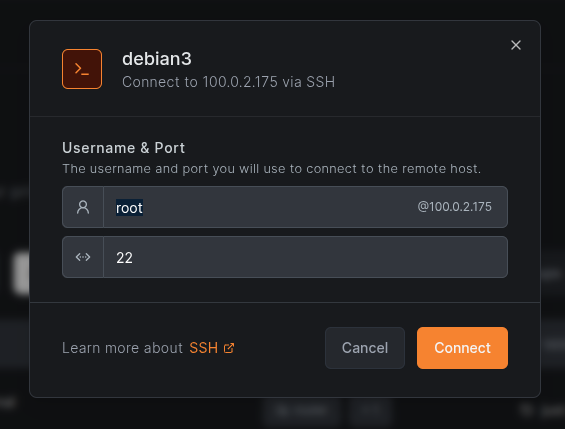
- Adjust the SSH username in the credentials modal if required
- Click Connect
- A terminal window will open in your browser with your SSH session
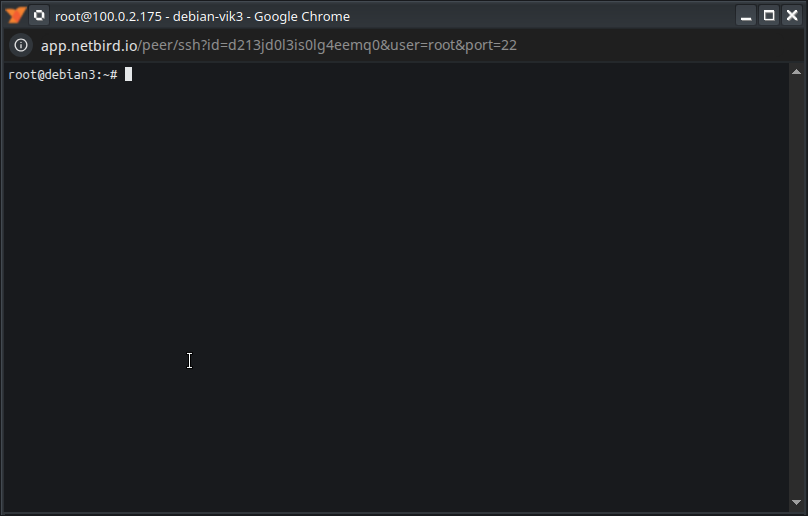
RDP Connection
For RDP access:
- Click the RDP button for your target machine
- A new window will open with a credentials modal - enter your RDP server credentials:
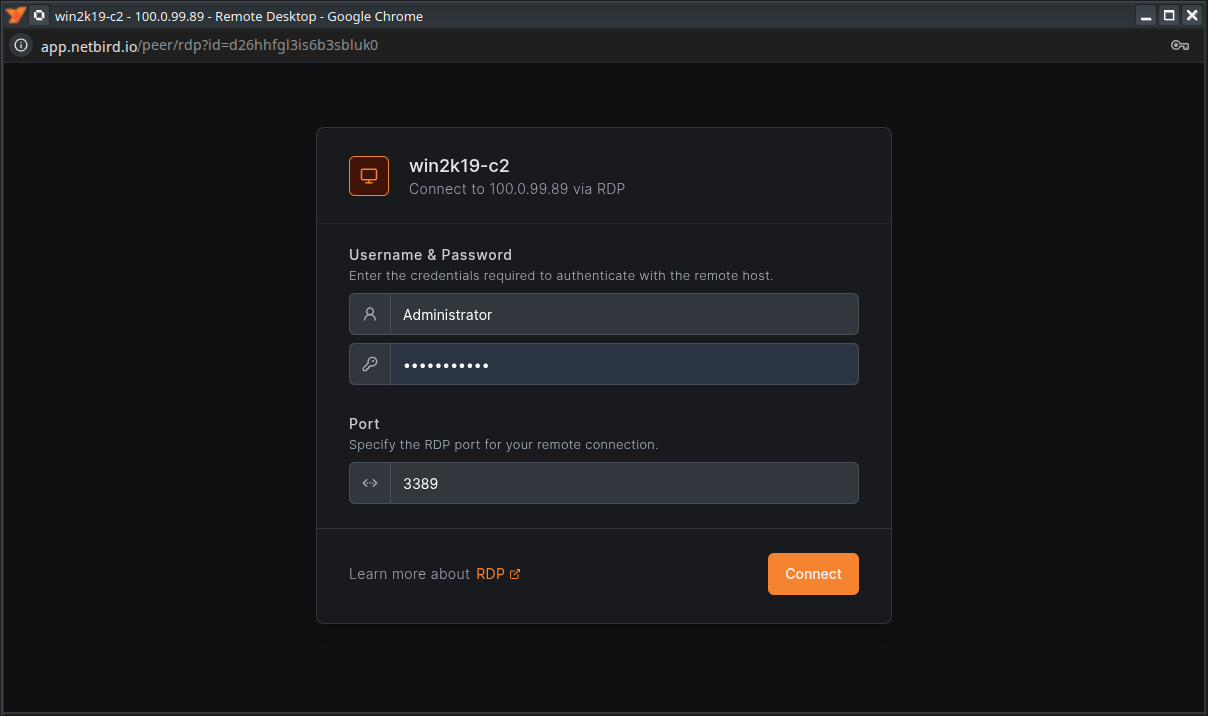
- Username: Your username (can include domain:
DOMAIN\username) - Password: Your password for the RDP server
- Click Connect
- In the same window, a certificate warning dialog will appear - review the certificate details
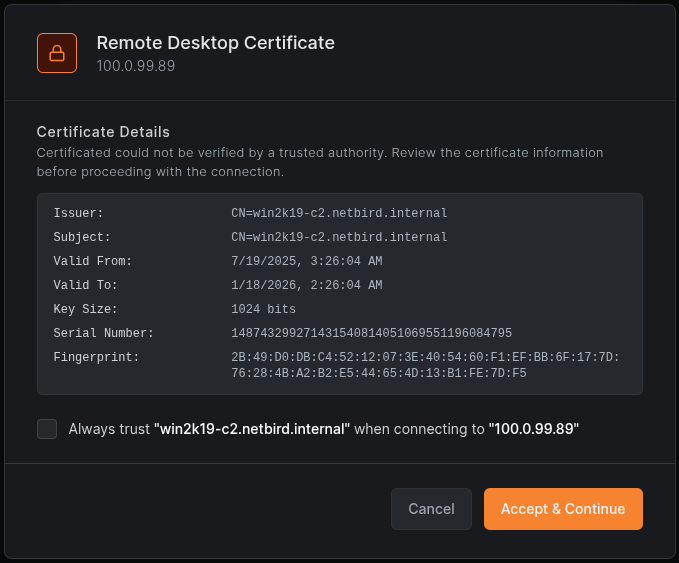
Certificate warnings appear for all RDP connections because the Browser Client cannot access the browser's native certificate store for validation. Accepted certificates are remembered using browser storage.
- Click Accept and Continue to proceed with the connection
- The remote desktop will load in the window
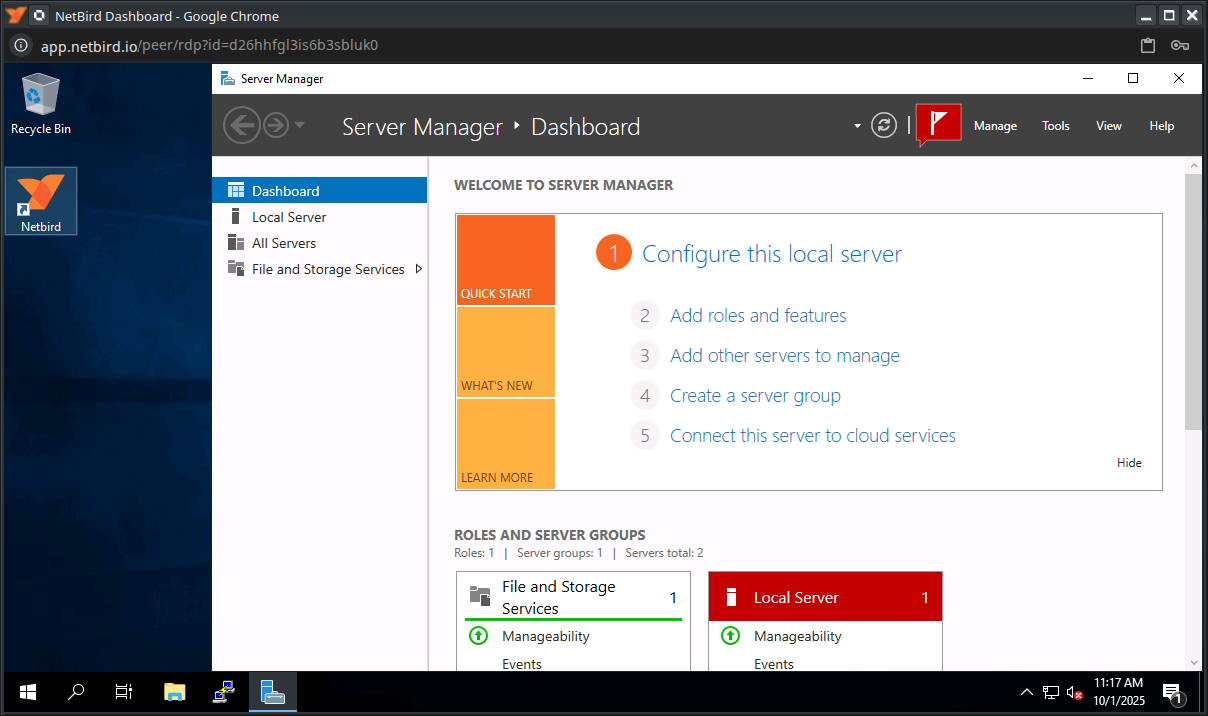
Connection Management
Active Sessions
While connected through the Browser Client:
- Session persistence: Sessions remain active as long as the browser tab is open
- Multiple connections: Open multiple tabs for concurrent sessions to different peers
- Clipboard support: Copy and paste text between host and RDP in both directions
Session Security
The Browser Client maintains NetBird's security standards:
- End-to-end encryption: All traffic is encrypted using WireGuard®
- Temporary access: Uses NetBird's temporary access mechanism that:
- Creates short-lived peers with WireGuard keys generated in the browser
- Establishes temporary ACL rules (TCP/22, TCP/3389)
- Automatically removes the peer and ACLs when the session ends
- No data persistence: Keys and credentials exist only in browser memory
Troubleshooting
Common Connection Issues
"Failed to initialize WASM"
- Clear your browser cache and cookies
- Ensure JavaScript is enabled
- Check if your browser supports WebAssembly
- Try using a different browser
"Connection timeout"
- Check that the SSH/RDP services are running on the target
"Authentication failed"
- For RDP, try including the domain in the username (e.g.,
DOMAIN\username)
Known Limitations
Browser Client Constraints
- Relay-only connections: No direct P2P connections (may increase latency)
- Advanced features: Some SSH/RDP features are not available (SFTP, sound, file shares, etc.)
- Concurrent connections: Browser resource limits may affect multiple simultaneous sessions
- RDP resolution changes: Require reconnection (not seamless)
Technical Implementation
For technical details on the Browser Client architecture, see the Browser Client Technical Architecture documentation.
SSH Requirements
For SSH access through the Browser Client:
- NetBird SSH must be enabled on the target peer
- The browser generates WireGuard keys and pre-registers the peer via the temporary access endpoint
- Authentication uses the pre-generated WireGuard key pair (bypassing the usual OIDC or setup key flow)
- The WASM NetBird client handles SSH connections internally
RDP Technology Stack
The RDP implementation is 100% client-side using:
- IronRDP: High-performance Rust RDP client (Apache 2.0/MIT licensed)
- RDCleanPath proxy: IronRDP's rdp proxy reimplemented to make use of NetBird
- Both components are compiled to WebAssembly and run entirely in the browser
Security Considerations
When using the Browser Client:
- Always connect from trusted devices - The browser environment should be secure
- Use incognito/private mode on shared computers to ensure no session data persists
- Log out properly - Close the browser tab to ensure the session ends
- Keep your browser updated to receive the latest security patches
- Be cautious with browser extensions that might interfere with or monitor your sessions
The Browser Client provides a convenient, secure way to access your network resources without installing software, perfect for quick access from any device or when working from temporary workstations.

